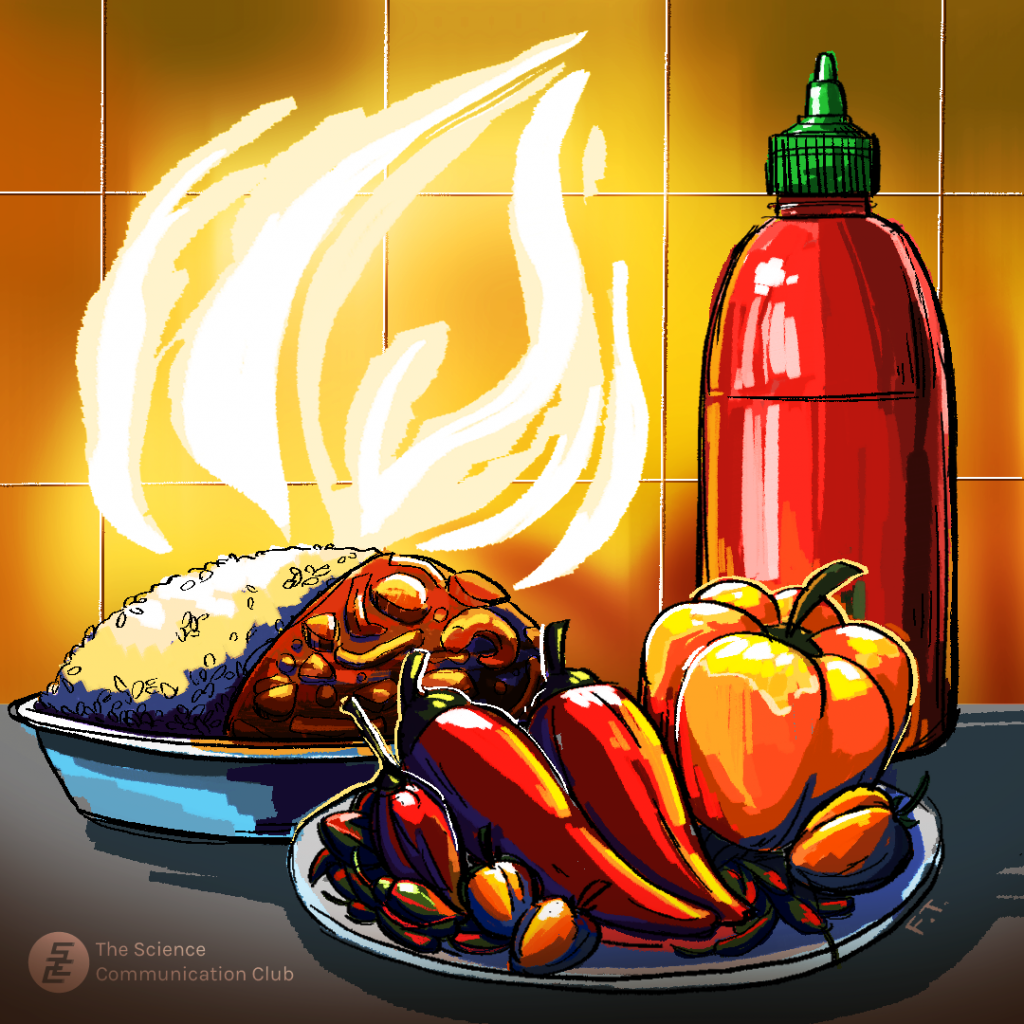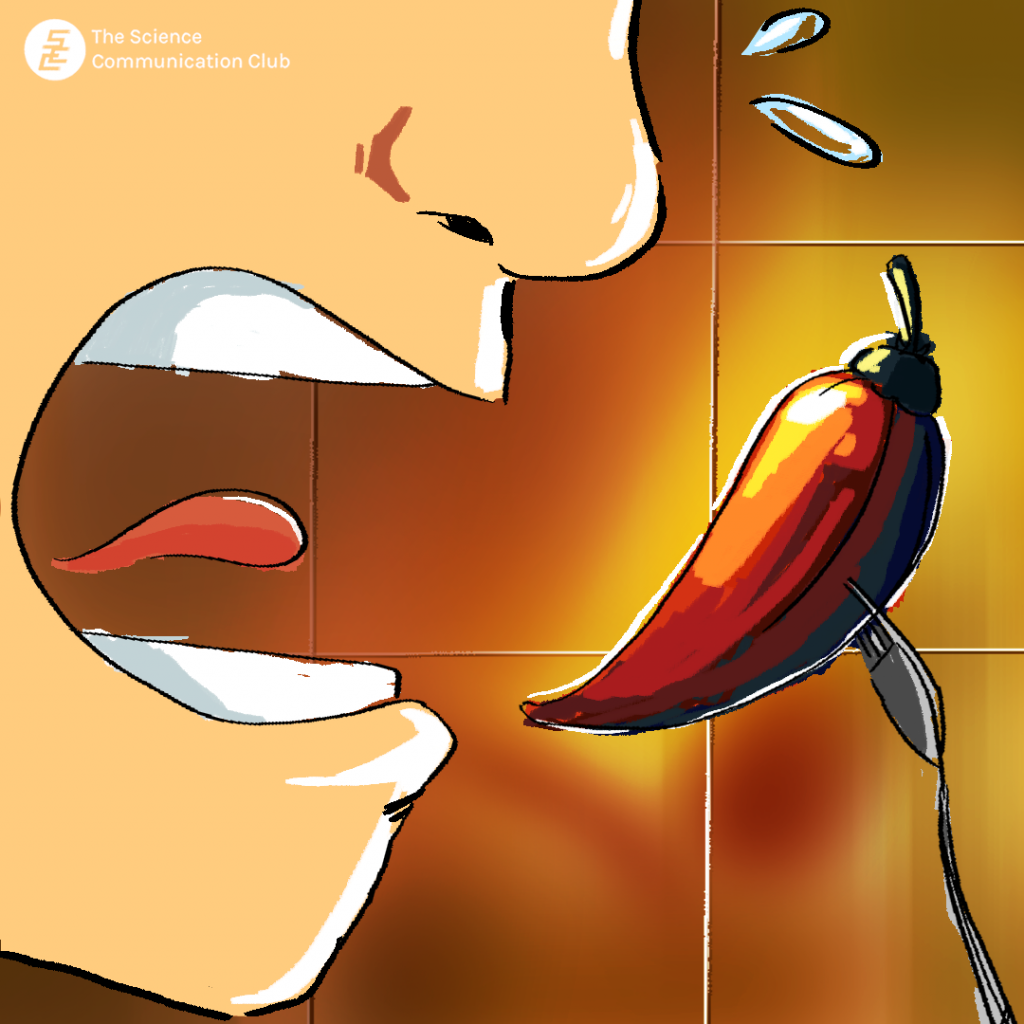
Written by Angie Lo
Illustrated by Fiona Tung
From curry to chili to anything smothered in hot sauce, spicy food is savoured by many. But what is it that gives these foods the zing and heat we love? This article dishes out the science behind tasting and enjoying spice.
The secret to spicy food lies in a molecule called capsaicin. This compound is found abundantly in hot peppers and the many ground spices made from them. So what does capsaicin do? Well, the neurons in our mouth have special receptors called TRPV1 receptors. Activated by high temperatures of 43°C or more, they’re responsible for sending signals that help us sense the heat in our food. As it turns out, capsaicin has the ability to activate these receptors too! So when we consume spicy food, no matter the temperature, TRPV1 will start firing—sending a signal up to the brain and producing that same familiar, hot sensation.
Spicy foods can also have different heat-inducing compounds—for instance, ginger has one called gingerol, while black pepper has one called piperine. Both also activate the TRPV1 receptor in the mouth. Yet other foods considered “spicy”, such as wasabi or mustard, contain a compound called allyl isothiocyanate. Rather than TRPV1, however, this compound mainly activates receptors called TRPA1. These help detect irritants instead of heat, but can also induce a burning-like sensation. So even though wasabi’s not actually dangerous, you’ll still feel that characteristic sharp sting when you eat (still delicious, though!)

That sweet, sweet heat
How did spicy food come to be so popular? A burning mouth doesn’t seem to be a sensation that matches up with pleasure. Yet humans appear to have latched onto hot peppers so much that they’ve found their way into tons of dishes around the world. We’re not totally sure of how, but several theories have been postulated to explain its beginnings and pervasive rise.
One such theory is the thrill-seeking hypothesis. It claims that we enjoy spice because that intense, burning feeling excites us—we get the thrill of danger while knowing we won’t really be hurt. It’s the same kind of reasoning behind why some people love going on terrifying amusement park rides or visiting haunted houses.
Another theory states that because spices like chili have antimicrobial effects, they may have been added to a variety of dishes in the past to make them safer to eat. Yet another draws from studies showing that capsaicin leads to decreased energy intake, speculating that people may have latched onto chili because it helped curb their appetite for other foods. Yet others think that hot peppers were initially used more for their flavours than their heat, jazzing up a diet in a time where foods may have otherwise been bland. From these starting points, people may have grown accustomed to and taken a liking to the heat.
Whatever the reasons may be, there’s no doubt that spicy food is a beloved favourite—with some awesome science behind it to boot. So, to all spice-lovers out there: dig in!
Sources:
- Gerhold, K. A., & Bautista, D. M. (2009). Molecular and cellular mechanisms of trigeminal chemosensation. Annals of the New York Academy of Sciences, 1170, 184–189. https://doi.org/10.1111/j.1749-6632.2009.03895.x
- McNamara, F. N., Randall, A., & Gunthorpe, M. J. (2005). Effects of piperine, the pungent component of black pepper, at the human vanilloid receptor (TRPV1). British Journal of Pharmacology, 144(6), 781–790. https://doi.org/10.1038/sj.bjp.0706040
- Spence, C. (2018). Why is piquant/spicy food so popular? International Journal of Gastronomy and Food Science, 12, 16–21. https://doi.org/10.1016/j.ijgfs.2018.04.002
- Yin, Y., Dong, Y., Vu, S., Yang, F., Yarov-Yarovoy, V., Tian, Y., & Zheng, J. (2019). Structural mechanisms underlying activation of TRPV1 channels by pungent compounds in gingers. British Journal of Pharmacology, 176(17), 3364–3377. https://doi.org/10.1111/bph.14766